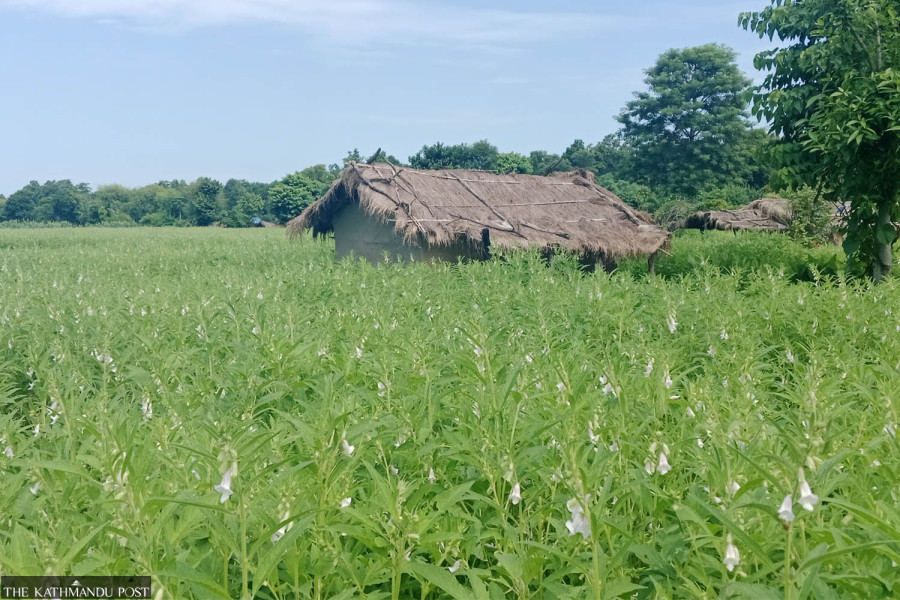Sudurpaschim Province
22 years and 33 panels later, Shuklaphanta displaced families still in limbo
Failure to rehabilitate hundreds of families is hurting both their well-being and wildlife, say conservationists.
Bhawani Bhatta
The rehabilitation of hundreds of families displaced during the expansion of the Shuklaphanta Wildlife Reserve, now a national park, 22 years ago is still uncertain.
The displaced families are languishing in temporary camps while government authorities dig in their heels, refusing to tackle this longstanding issue. The failure to rehabilitate the displaced people, according to conservationists, has harmed both the local communities and wildlife in the Shuklaphanta area.
“I’ve heard another commission has been formed yet again for the rehabilitation of the displaced families. Our plight hasn’t changed a bit, despite the formation of several commissions and committees,” said Hira Singh Bhandari, coordinator of the struggle committee for the displaced families. He expressed little hope for the newly formed commission.
The Council of Ministers on September 18 formed a six-member judicial commission led by Jayananda Paneru, a former judge of the Sudurpaschim High Court. This commission marks the 33rd attempt to address the rehabilitation of the displaced families, but the problem remains unresolved.
Displaced people like Bhandari are not convinced that the latest commission will effectively tackle the longstanding problem. So far, 33 commissions, committees and working groups have been formed for the rehabilitation of those displaced during the expansion of the reserve. But none of these groups has found rehabilitation solutions, with most of them spending their time merely counting the displaced individuals.
Several commissions, committees and working groups did not even initiate their work while many others were bogged down in identifying the number of displaced families. According to data submitted by the 28th commission led by Thakur Prasad Sharma, there are 1,480 families in need of rehabilitation.
“The Sharma-led commission has trimmed the number of displaced families, leaving out some genuine cases while including some fraudulent claims. We have been living near the forest areas for the past 22 years, and the authorities seem indifferent to our plight,” said Bhandari. According to him, there are a total of 2,473 displaced families in Kanchanpur.
Only a few commissions and working groups recommended the rehabilitation of the displaced families, but their suggestions went unheeded. The 30th commission proposed providing each displaced family with 10 kattha (0.338 hectares) of land or Rs6 million in compensation, but that recommendation was ignored.
When the wildlife reserve expanded its eastern front, dozens of settlements were uprooted, and around 5,200 families were resettled by the Ministry of Forest and Environment. They had been relocated to wards 14 and 16 of Bhimdatta Municipality, ward 10 of Bedkot Municipality and Simalphanta area of Shuklaphanta Municipality.
However, hundreds of the displaced people are still languishing in temporary camps. They are currently scattered across various camps in Dhakka, Tarapur and Lallare. Among these, Dhakka is the largest, with 604 families, while Tarapur camp accommodates 180 families and Lallare has 13 families.
Similarly, many other displaced people have been staying at Bani, Sisamghari and Malubela of Krishnapur Municipality, Simalphanta, Banahara and Baisakha of Shuklaphanta Municipality and Duda of Belkot Municipality among other places in Kanchanpur, a far-western Tarai district in Sudurpaschim Province.
Living in the camps close to the forest is both difficult and unsafe, as residents are left with constant fear of wild animals which not only threaten their lives but also destroy the crops they grow. The displaced people have resorted to encroaching on forested areas for agriculture. Meanwhile, this close proximity between humans and animals has adversely affected both.
Conservationists say that while humans live in constant fear of wildlife attacks, the wild animals find their natural habitats disturbed by human activities leading to frequent human-wildlife conflicts.
The coordinator of the newly formed commission expressed his commitment to working on the rehabilitation of the displaced families as per the mandate given to the commission. “I was informed about the formation of the judicial commission to rehabilitate the displaced people, but I am still in the dark about the specifics of the mandate given to the commission,” said Paneru.
Established as a wildlife reserve in 1976 and declared a national park in 2017, Shuklaphanta is located in the southwestern corner of Nepal in the Sudurpaschim province. As per the latest count, the national park is home to more than 2,300 swamp deer and 44 tigers. After its expansion on the eastern side, the Shuklaphanta National Park now spreads across 305 sq km.




 9.88°C Kathmandu
9.88°C Kathmandu










